Yle Kioski Investigated: This is How Pro-Russia Trolls Manipulate Finns Online – Check the List of Forums Favored by Propagandists
Hostile trolls distributing propaganda messages from the Russian leadership try to silence and mislead Finns and to manipulate the Finnish public discussion online according to the journalistic investigation of Kioski on pro-Russia trolls.
Pro-Russia trolling, in other words, aggressive online texts following the agenda of the Kremlin is everyday reality on many websites used by Finns. The distribution of false information supporting the information warfare waged by the Russian leadership has increased significantly after the Ukraine crisis escalated.
Kioski gathered information on pro-Russia trolling from several independent sources: experts, administrators of Finnish websites and Finns who have been targeted with trolling. In addition to this, our journalist followed the activity of secret profiles supporting the information warfare waged by the Russian leadership online for dozens of hours and was targeted by them, as well.

Finnish Internet users are one of the most important sources of information in this article. Last autumn, we asked Finns about their experiences and observations about pro-Russia trolling. We received about 200 stories by phone or email and via Facebook and Twitter. Majority wanted to tell their story anonymously: many were afraid of becoming targets of the trolls, and some of them claimed anonymity due to their profession.
Previously, there have been news stories about pro-Russia trolls trying to influence the Finnish leaders of the state and other public figures. The material gathered by Kioski reveals that texts that confusingly resemble discussions between members of the Finnish people are aimed at influencing the opinions of regular Finns, in addition to the leadership of the country.

Kioski found and received reports on pro-Russia troll comments and distribution of disinformation on these websites used by Finns: the social networking services Facebook, Twitter, VKontakte, and Google+, the video sharing services YouTube and LiveLeak as well as their comment sections, discussion forums Reddit, Topix.com, Pprune, Russian.fi, Suomi24, MuroBBS and Vauva.fi.
In addition, Kioski and people who sent us their stories noticed trolling in the comment sections of these media: The Guardian, CNN, Bloomberg, The Moscow Times, Forbes, Kyiv Post, Yle, Iltalehti, Ilta-Sanomat, Helsingin Sanomat, MTV3, Kaleva, Etelä-Saimaa, Kauppalehti, Taloussanomat, Markkinointi&Mainonta, Tiede, Verkkouutiset, Uusi Suomi, Kymen Sanomat, Kansan Uutiset, Tiedonantaja, Satakunnan Kansa, Kainuun Sanomat and Itä-Savo.
On the Internet, there are also several websites distributing Russian propaganda. These include Sputnik News, the blog of Johan Bäckman, Finnbay, Verkkomedia, sott.net and mvlehti.net, for example. There are a lot more disinformative websites in English and Russian.
This article concentrates on the disinformation ingratiating the Kremlin anonymously distributed on forums used by Finns that seems systematic and organised according to the content or vast number of messages, for example.
However, it’s good to bear in mind that stating the views of the Russian leadership or defending them in an appropriate and matter-of-fact way does not make an anonymous participant in the discussion a troll, much less anyone using their own name. When talking about information warfare, trolling means organised and aggressive online influencing.
Manipulated photos from the Kremlin media straight to the faces of Finns
Trolls prefer to share news published by sources they see as trustworthy, for example Russia Today (RT), Channel One (Pervii Kanal) and Sputnik News.
On websites regurarly used by Finns, trolls share disinformation and manipulated photos, usually related to Russia or the war in Ukraine, and present them as the truth. This material often originates from the Russian state media controlled strictly by the Kremlin, and it conforms to the statements of the most visible top politicians in Russia. Trolls prefer to share news published by sources they see as trustworthy, for example Russia Today (RT), Channel One (Pervii Kanal) and Sputnik News.
For example last November trolls shared “a sensational news story” and a photo published by the Russian State Channel One among Finnish Facebook users. According to the story, a Ukrainian fighter plane shot down the Malaysia Airlines passenger plane in Eastern Ukraine. The photo was soon found to be a forgery.
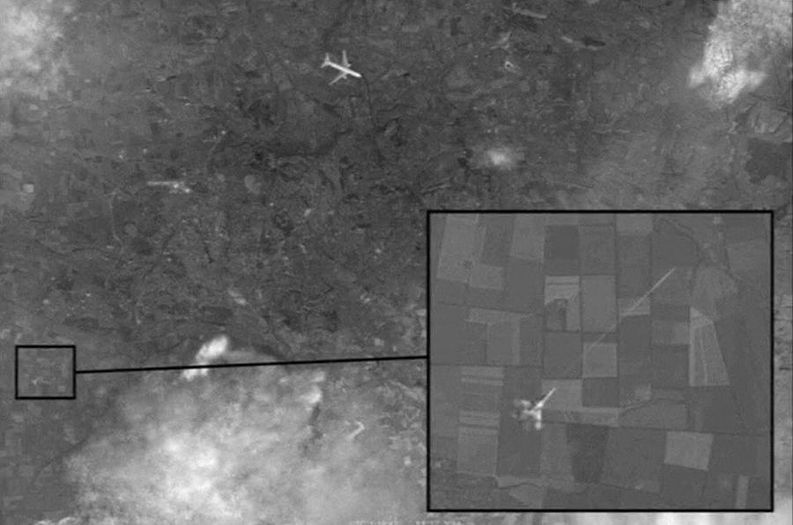
Trolls also share propaganda videos, link militant memes and turn facts upside down.
In the flood of Finnish, English and Russian troll messages the same phrases are constantly repeated: Russia and President Vladimir Putin are idolised and the military operations of Russia in Ukraine are justified - or completely denied.
The Ukraine war is blamed on the United States, the European Union, and “the fascists of Ukraine”. Finnish politicians are scolded for being anti-Russian and warmongering. The same message are copied exactly or nearly identically on several Facebook pages and news websites or sent to several users on Twitter.
Examples of troll messages:
"There was an unlawful fascist coup in Kiev, and an unlawful military junta has the power."
"The Western countries are fascist and the leaders of the Western countries are Nazis."
"Fascists invaded Eastern Ukraine. There is no proof of the presence of Russia in Eastern Ukraine."
"Russia has not broken international law by annexing Crimea."
"Putin wants peace and negotiations but the President of Ukraine is a crazy militarist."
"Finns are racists who hate Russians. Russia is a good neighbour to Finland and more important than any other neighbour."
Pro-Russia trolls often steer comments towards other subjects. For example, if someone criticises the actions of the Russian President Vladimir Putin, the discussion is diverted to the United States policy in Iraq or the Northern Atlantic Treaty Organization NATO. In our previous story, The Troll Factory in Saint Petersburg, we revealed that each day, paid trolls are given the topics of the day and they write as many as a hundred messages a day on various forums behind several fake profiles.
In the troll messages, fallacies and erroneous reasoning are common and the tone is often typical for propaganda: preaching and uncouth, says one Finn who shared their experiences.
– I recognise a repulsive tone in trolling, resembling the old-school propaganda the Soviet Union used to distribute. Truth has no intrinsic value in itself.
Trolls constantly demand proof from other participants in the discussion but are unable to provide firm proof for their own claims.
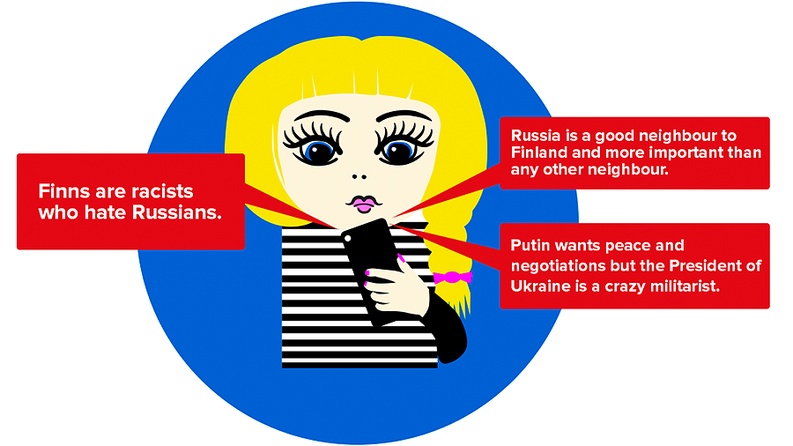
Fake profiles spit out propaganda on Facebook and block those who disagree
When Russia annexed Crimea, discussion forums used by Finns suddenly received countless new members and there were many new accounts created on Facebook, says a Finnish defence expert who doesn’t want their name made public because of their work.
– Some of these Facebook profiles are very clumsy but some of them are created very skilfully. Looking at them, it’s very hard to judge if you’re dealing with a real profile. Using these profiles, trolls fill social media discussions with propaganda shamelessly praising Russia, the expert says.
Some secret profiles are adorned with the picture of a beautiful woman. When searched, it’s revealed she’s not a real person but a photo from an Internet image bank instead. These profiles add Finns on their Facebook, and many people have accepted these friend requests.
There are also several secret and public groups on Facebook distributing aggressive disinformation and pro-Russia propaganda that appeals to people’s emotions. Usually, these groups kick out moderate members critical of Russia, block them, or freeze them out by bullying. The names of the groups are nearly always misleading.
Trolls try to pick fights on Russian-speaking discussion forum
On the biggest Russian-speaking discussion forum in Finland, russian.fi, trolling escalated last winter after the trouble in Ukraine started, says Veronika Solovian, the administrator of the website. According to Solovian, at least a part of fierce pro-Russia trolling in Russian is information warfare controlled by Russia.
The trolls on russia.fi comment on political topics very actively and always solely defending Putin and his policy. Trolls are able to draw other participants into arguments, and the others don’t necessarily immediately identify them as trolls.
Veronika Solovian, the administrator of russian.fi, thinks it’s extremely problematic that nobody can unambiguously identify or point out conversationalists distributing pro-Russia propaganda as paid writers. Some of them may be ordinary private citizens.
– This distorts the positions on our discussion forum and is not fair on other users, says Solovian.

It seems like the work of a troll operating under the cover of a fake profile or pseudonym starts early in the morning. Tiina Santala who used to moderate the discussion in the comments section of the Helsingin Sanomat web news says that even before the war in Ukraine, Helsingin Sanomat was bombarded with pro-Russia messages that resembled brain wash and propaganda 24/7 all year round.
The flood of messages praising the views of the Russian leadership and scolding the United States and NATO didn’t subside even on public holidays.
– Commenting was clearly orchestrated. The same message with the same content could be sent to be published as many as a couple of hundred times, says the former moderator.
Moderators try as best as they can to screen the flood of messages and only publish appropriate matter-of-fact comments and ones that don’t seem orchestrated. In spite of that, trolling also ends up on discussion forums for everyone to see.
After the events in Ukraine, the number of trolling messages sent to Helsingin Sanomat has increased even more, says Petri Korhonen, the Managing Editor of Helsingin Sanomat.
– There’s a distinct peak whenever a bigger news story about Russia or Ukraine is published: the number of trolling messages is multiplied compared to the amount of messages prior to the war in Ukraine, says Korhonen.
Diversionary Twitter accounts attract Finnish followers
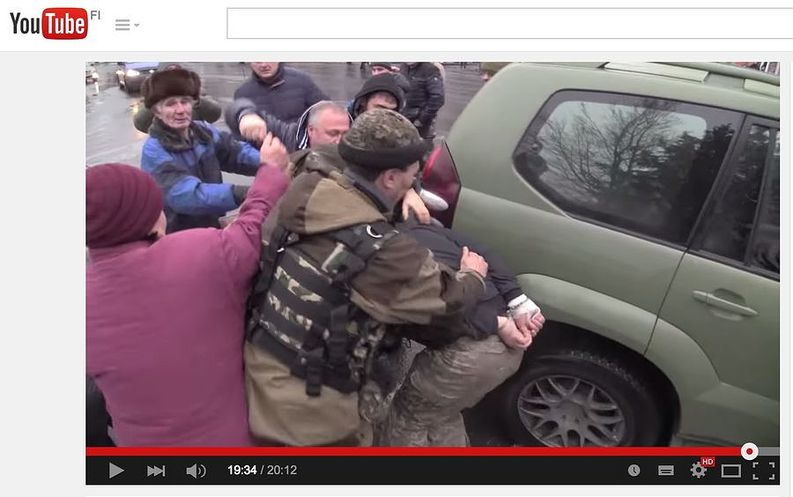
On Twitter, there are several diversionary accounts Finns follow. The descriptions of the fake accounts claim that the tweeter is a researcher, security expert, or another proper businesslike person.
In reality, the account holder doesn’t reveal their name even when asked, tweets content that looks confusingly decent and convincing but systematically repeats the propaganda of the Russian leadership between appropriate messages.
Some of these accounts also block those critical of the Kremlin or call people names if they ask about the background of the account. Often, fake accounts on Twitter have a lot of followers who seem bought or otherwise suspicious, and they also follow other fake accounts.
In addition to this, there is a vast amount of suspicious and aggressive trolling under several popular hashtags on Twitter. These hashtags include the likes of #russia, #ukraine, #donetsk, #mh17, and #nemtsov, for example.
Anonymous troll whistle-blower: pro-Russia trolling is systematic
Some of the pro-Russia lies and photo manipulations spread amongst Finns are revealed by a Facebook page called "Verkkomeedio - Neutraali uutispalvelu". One of the page administrators tells that disinformation and fake photos seem to originate from VKontakte and other Russian websites. The administrator we interviewed doesn’t want to reveal his/her name in public because trolls have threatened him/her.

– The operations are systematic and new material constantly appears, says the administrator.
The administrator of the Facebook page Verkkomeedio has noticed that one troll may use dozens of fake pseudonyms. In addition, there are several bot accounts on Twitter that tweet the same messages word for word, at the same time, slandering the President of Ukraine, for example.
According to the administrator, it’s hard to prove the connection of trolls with the Russian leadership. The themes and views in their texts and comments are, however, always the same as the ones of the Kremlin.
Anonymous trolls often reply to decent matter-of-fact questions in a very inappropriate manner or not at all. Instead, they continue ranting or move on to fill other threads with their messages.
Nobody knows how many trolls sending their messages on Finnish computers and smart phones are paid for their work, how many of them work in a controlled manner in some way or another, and how many people distribute pro-Russia propaganda for reasons of their own.
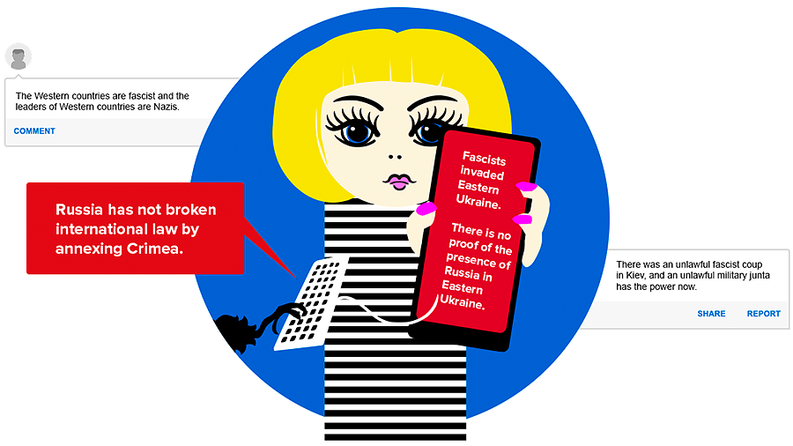
Tools: Lies and psychological harassment
Secret profiles treat Finns who criticise Russia in their own name in a very cold manner. In addition to the administrator of the Facebook page Verkkomeedio, many others told us about threats, name-calling and derogatory comments.
The trolls write and swiftly distribute, even internationally, lies and false evidence about Finns who comment on the domestic policy of Russia or its actions in Ukraine in their own name.
Security policy blogger Janne Riiheläinen from Joensuu is an active Twitter user, and targeted with fierce trolling. Trolls haven’t only berated him but also people who have retweeted his tweets concerning Russia.
– Pro-Russia trolls use the same tools as bullies in school. Name-calling - which can also be classified as psychological abuse - is one of these tools, says Riiheläinen.
A certain secret profile systematically distributing pro-Russia propaganda has called Riiheläinen names in its Tweets hundreds of times. He has been called “a Russophobe” and “a Nazi”, for example. Trolls have labelled Riiheläinen “a crazy militarist” and “a warmonger” although he comments on security policy and Russia in a moderate manner.
– A normal person doesn’t even want to discuss the whole topic anymore after being called names, says Riiheläinen.
Countless other Finns have also been targeted with the same kind of name-calling and propaganda on Twitter.
A Finnish journalist having discussions on Twitter says the distribution of disinformation started immediately after he tweeted “Save Russian journalists from Putin”, referring to the poor freedom of speech in Russia. He wants to remain anonymous, as well, so that he can work in peace.
– After a short while, tweets were sent all over the world in my name saying a Finnish journalist who worked in Russia demands the release of the Russian journalists [being held in Ukraine], says the journalist.
The social media strategy of the Russian Embassy is confusing
The activity of the Russian Embassy in Helsinki on Facebook and Twitter has also received attention. On Twitter, @russianembfinla has not only blocked Finnish journalists who have commented on Russia and the situation in Ukraine in a critical manner but also private persons, distributed photos of Ukrainian civilian victims, retweeted texts of pro-Russia trolls and anonymous messages of those critical of the West as well as altered messages of Finnish tweeters.
According to experts, the activity of the Russian Embassy in the social media is not only undiplomatic but also trolling. Early March, the Embassy shared a link on its Facebook page for a propaganda video about a Russian occupier that had been published on the webpage Venäjän ääni, The Voice of Russia. When Finns commented on the undiplomatic video on the Facebook page of the Embassy, the Embassy deleted critical comments.
At the same time, comments praising the video and berating Finns were left on the page, also a message by a commentator using a secret pseudonym.
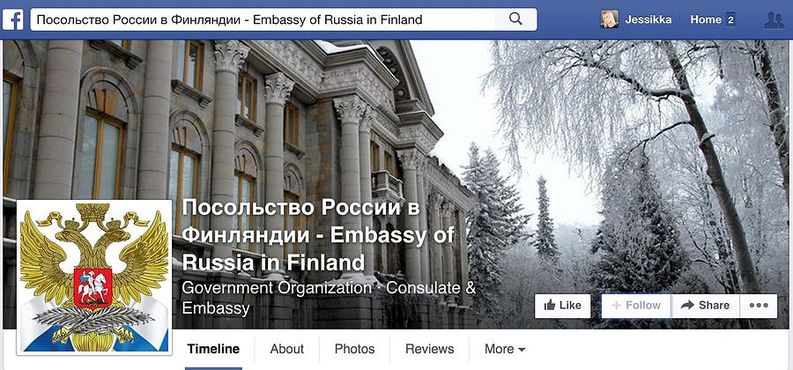
Janne Riiheläinen, a security policy blogger and troll victim, had his hashtag hijacked by the Twitter account of the Russian Embassy. It happened last summer when Riiheläinen encouraged people to participate in a virtual peace protest on Twitter, on the Twitter feed of the Russian Embassy with the hashtag #rauhaakiitos (#peaceplease). After the protest, the Twitter account of the Russian embassy said the message had been sent “to the wrong address” and told everyone to ask the Foreign Ministry of Ukraine for peace.
After that, the Russian Foreign Ministry and the Russian Embassy in Finland have several times used the hashtag #rauhaakiitos to promote their own agenda, for example, when demanding Ukraine to provide peace - although Russia is participating in the conflict.
According to Riiheläinen, the incident reveals the virtual information warfare tactics of Russia.
– It seemed absurd. I sent one tweet to organise a small virtual peace protest because I wanted to do something. And now my hashtag is being used by Moscow. My educated guess is that on the arrival of the Twitter storm, the employees of the Russian embassy have been advised to reclaim the hashtag, says Riiheläinen.
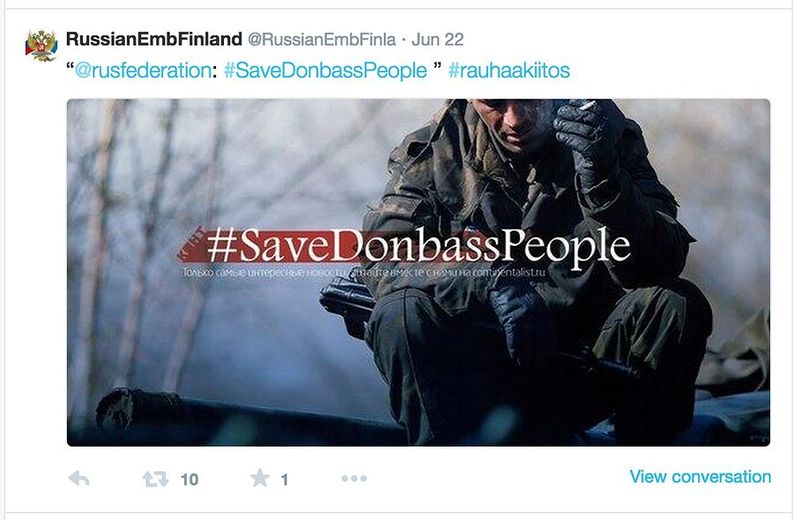
The Russian Embassy in Helsinki did not get back to us about our requests for an interview.
International pro-Kremlin trolling has been identified in several countries. In addition to Russia, it has been reportedly observed at least in Britain, the United States, and Latvia where the security police are investigating pro-Russia propaganda trolling on websites used by Latvians. For the time being, there is very little scientific research done on pro-Russia Internet trolls and the effects of them. In Finland, the subject has been discussed by Researcher Saara Jantunen from the Finnish Defence Research Agency, among others.
You can participate in the discussion about hostile pro-Russia influencing in the social media on Twitter under the hashtag #venäjätrolli. We encourage everyone to use their own name and conduct the discussion in a moderate manner without name-calling. READ ALSO: Here is how the trolls have succeeded in twisting the Finnish public debate.
Read Finns’ stories and experiences about pro-Russia trolling
The same messages are copied on comments sections of newspapers.
“I am an avid reader of YLE, Ilta-Sanomat and the CNN news. Mainly during this year, 2014, there have been pro-Russia texts that seem like systematic propaganda [on the news comments sections of all of these media]. I recognise a repulsive tone in trolling, resembling the old-school propaganda the Soviet Union used to distribute. - - Truth has no intrinsic value in itself which makes it repulsive. Odd comments are often awkward and uncouth, as well, superficial, ranting, and somehow like targeted at retarded people. In other words, typical propaganda created on orders.”
“In the context of the news in daily papers that even slightly touch the subjects of Russia or Ukraine, the comments sections of the electronic media contain praising messages or slander labelling the piece of news false. These messages really bother me, at least. They seem to typically see the United States as the bad guy and Putin and Russia as the good guys.”
“The objective [of troll s] is to stop all direct and clear criticism towards Russia. When I started to directly criticise Russia because of its unpredictability, impudence, and threatening behaviour towards other Western countries and small independent democracies, in particular, the clarity and directness were stopped by pro-Russia writers. Or at least that was their objective: to silence all criticism.”
“The troll army has taken over the comments in the press, provincial newspapers included. For example, the comments in Helsingin Sanomat about news concerning Ukraine, NATO et cetera, are targeted with an unrestrained attack. They are trying to drive a wedge between the decision-makers in domestic policy, as well.”
“There is a scary amount of trolling around. If you dare criticise Putin and the actions of Russia, mention NATO or the United States, or question the truths firmly stated by the troll, you’re “a NATO loving hater of Russia”, “a NATO suck-up”, and “a traitor who wants to destroy the good relations Finland and Russia”. In addition, trolls wonder whether the blood money of the United States is burning in the pockets of the critic. - - The trolls idolise Putin as “the charismatic leader of democratic Russia that has the full trust of the whole people of Russia and whose solid an robust leadership skills even the West has had to admit”.
“When googling, I noticed a very prolific [pro-Russia] troll who rewrites the history of Finland in local newspapers and political blogs. The message is always the same. The troll probably has a set of different phrases they post systematically in every media.”
“In late summer, the trolling started under every piece of news on Ilta-Sanomat about Ukraine, as early as five or six o’clock in the morning when Finns are still asleep. For a couple of weeks, it followed the same pattern: distraction and redirecting the discussion to other subjects. I still remember the satellite photos from Ukraine; they immediately triggered “a discussion” about the satellite photos of the United States before the war in Iraq. It was blatantly clear somebody was deciding what the others should write about. Words misspelled in the same way and points of view were repeated in an all too transparent way.”
“Pseudonyms or fake names are posting theories that are totally absurd. They praise Putin and slander Ukraine, for example like this: “The shitty trash of Ukraine lost the war” etc.”
“During the trouble in Maidan, already, the comments sections of tabloids, in particular, were flooded with countless people causing disturbance, distributing disinformation and trying to berate others and to label all comments supporting Ukrainians as false. In the beginning, the comments were quite sharp and malicious and aimed at discrediting every comment supporting the revolution in Ukraine. Later on, the comments were distracting, aimed at redirecting the attention somewhere else like the actions of NATO, the United States, and the EU. Lately, there have also been indications of the fact that Facebook groups are being trolled, information is being used for all the wrong purposes, and people are trying to distribute disinformation.”
“In the spring, was astonished at the fact how many commentators there were [on the news comments sections of Finnish afternoon papers] one-sidedly stating the views of Russia and Putin and belittling the current government in Ukraine, calling it “an unlawful military junta”.
“When Russia occupied Crimea, most of the comments on Ilta-Sanomat saw it as a positive thing. - - The troll army started to actively comment on two types of news, especially: ones talking about the United States and NATO, and ones discussing the position of Estonia. It was clear that in those cases some criteria was met and the counterreaction was very strong. -- Sometimes, the tone got threatening.”
Fanatical disinformation distributed on Facebook
“I participated in a Facebook group discussing Ukraine, and other Internet discussions. I tried to comment analytically and use international sources, as well. Nearly always, about one to three people started to comment on my opinions. They often adopted the following tactics: they were constantly demanding proof to support my views, and no proof was enough. On the other hand, they had information from the Russian Government and the publication Russia Today or its local Finnish “branches” that didn’t have to be proved. Ukrainians and the Ukrainian Government were simply called fascists. The communication was labelled by aggression and fanaticism. Putin was praised, the significance of the sanctions imposed by Russia was belittled, and the strength of Russia was emphasized. A bit like the olden times...”
“I’ve been added to Facebook groups with a very Putinistic agenda without asking me. The majority of the most prolific members are - - or characters that appear on several pages with a profile picture of something else than their own face. The post the same news articles in different groups. Some of the groups have said they are closed groups and for like-minded people only.”
“I started getting friend requests from poorly fabricated Facebook profiles. Everyone adding me was a beautiful young woman. According to the history of the profiles, they were all created recently and they had a couple of dozens of friends. What was most disturbing was the fact that these “friends” included a significant number of well-known politicians from all walks of life, even Members of the Parliament.”
Messages twisted on Twitter
“When Russia started the Crimea occupation, some Russian journalists were captured in Ukraine. I tweeted: “Save Russian journalists from Putin.” After a short while, tweets were sent all over the world in my name saying a Finnish journalist who worked in Russia “demands the release of the Russian journalists”. Putin was not mentioned in these trolling tweets at all. I have such strong experience about Russia that I wasn’t even that bothered, really, but I started getting messages all the way from Australia. I tweeted my original message again and emphasized Putin’s role in suffocating freedom of expression. As a consequence, certain “docents” in Finland started to bombard me on Facebook and Twitter whenever I even remotely touched the subject of Russia.”
“I was having a heated discussion on Twitter with two pro-Russia trolls who used Finnish names and presented themselves as private persons. - - According to the history of the accounts, they can cope with three hours of sleep a night. Our discussion attracted attention because after it ended, I started getting followers on my account. One of the first ones was Russia Today, and there were a few accounts the content of which was clearly looking out for the interests of the Russian information warfare. - - I came to the conclusion that what happened was operative, not random.”
“I started to follow a Twitter account whose messages were mainly Russian propaganda concerning Ukraine. I asked about the background of the account and said it would be easier to have a discussion if it was better known who was behind the tweets. The account blocked me. After this, there was a discussion on Twitter about pro-Russia trolls and [this account] was mentioned as an example. The account mentioned also participated in the discussion. I tweeted about the account, and as a reply from a Chinese (?) account I received a shocking photograph of a small baby in hospital with tubes sticking out and with a disfigured face and head. I haven’t done anything about it but it was clearly connected to the troll discussion. I interpret the photo as some kind of a warning.”
“I experienced things on Twitter that felt like trolling conducted by our Eastern neighbour. In addition to other tweets and retweets, I used my account for posting tweets critical of the Kremlin. I started to receive comments now and then that contained gibberish and a shortened link to malware or a website that had a virus on it.”
Systematic trolling on international websites
The video sharing website LiveLeak is full of pro-Russia video propaganda, and the comments section is flooded with hostile comments towards the West. The comments sections of YouTube videos about the war in Ukraine are also bombarded in the same way, not to mention Twitter.”
“The website militaryphotos.net contains very strong pro-Russia trolling. The pseudonyms are newly-created ones (March 2014 and after), the discussion is active, there are many trolls, and the domiciles have been dispersed all over the Western countries to mislead people. The objective is to create an image of a convergent opinion in the Western countries. But the content of the discussions reveals the tracks very clearly. - - There are dozens of fabricated troll personalities. If somebody brings up messages strongly commenting on the Kiev Government in a positive way, several trolls attack them at the same time. And the attacks are not mere yapping but there are carefully structured thought patterns that have no basis in reality when scrutinised more closely. In addition, the cruellest videos about civilian victims of the bombings are regularly published, all of them claimed to have been conducted by the Kiev Government, of course, without fail. The activity is so systematic it’s scary, it’s constant and intensive. All psychological means are used to attack those disagreeing.”
“I am a member of “the Russian Facebook”, the community “Русские не сдаются” on VKontakte. The title means “Russians will not surrender”. On the website, trolls are sharing messages and photos of the kind of content that would put the sender straight in prison in Finland. The whole objective of the website is to agitate others and create patriotic emanation as fierce as possible. In other words, it gets vulgar. It doesn’t matter to the commentators whether the claims are true or not, as long as they serve a certain purpose. There have been discussions on the website about whether Alaska should be rewarded the status of a republic or whether it should remain a regular oblast (state or province) the next time it’s occupied, for example.”
“Pro-Russia trolling in social media already started a few years ago. - - [On the forum Suomi24], the tone of the texts has become more arrogant. They’ve progressed from twisting things, disinformation, and lies, to personal slandering and abuse and threats that refer to the independence of Finland and its national existence.”
“It has been believed that pro-Russia propaganda is for internal use, meaning the Russian public. However, the format of the propaganda is largely the same in trolling only targeted at the Finnish public. The propaganda aimed at Finland thus seems crude and over the top because it seems to be a part of a large whole that is apparently distributed all over the world with the same concept. It is only modified in terms of language which can be seen as flawed language skills of the writer.”
“[The American] discussion forum Topix has a clear system: Ukrainians are called fascists and the word Nazi is used as a derogatory name. The forum is not moderated.”
The next article about trolling investigates the effects of pro-Russia Internet trolling on individuals, web discussions and, more widely, the society. Also read the first article in the series about the Troll Factory in Saint Petersburg where hundreds of people earn their living by praising Putin and distributing disinformation online – also in English and at night.